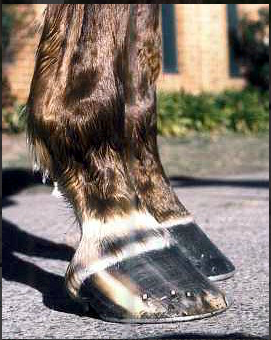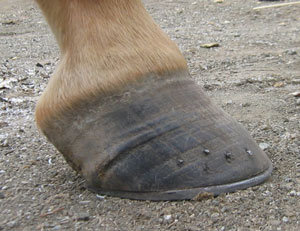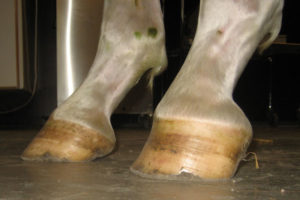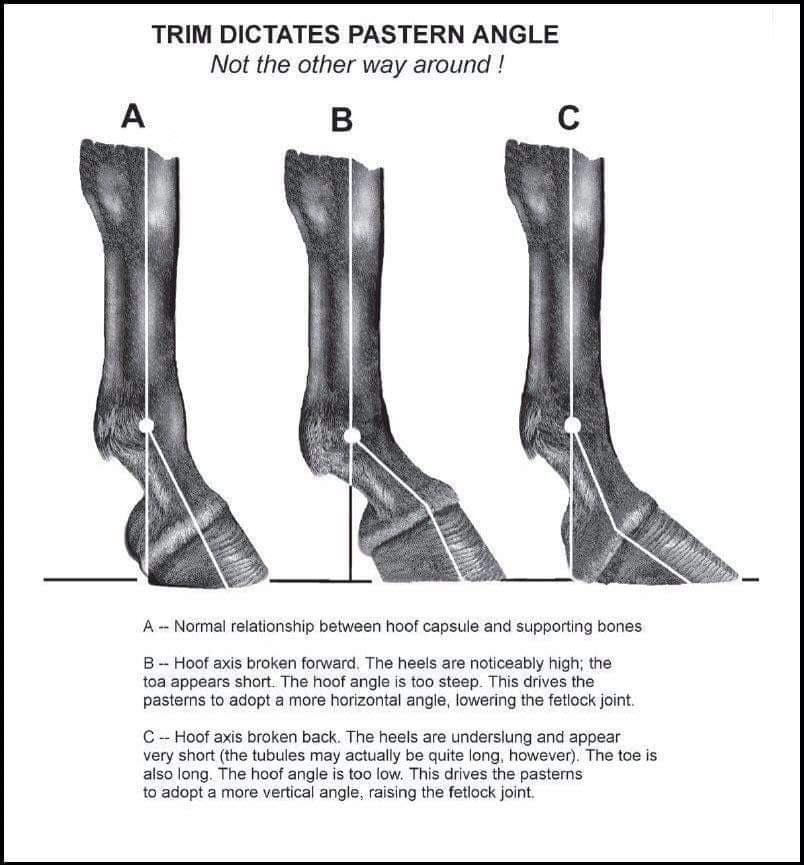what is another name for "toed in" in reference to judging the front legs and hooves of a horse?
Horse owners should be aware of how hoof angle tin chronicle to horse wellness.
The old adage, "No hoof, no horse," still stands truthful. Without a salubrious hoof, your horse'southward overall health will be compromised. As caretakers of horses, it is of import to know the nuts skills to evaluate the health of your equus caballus's hooves. What many people may not realize is that improperly trimmed hooves can not simply be unappealing but could potentially crusade farthermost pain and fifty-fifty lameness if left uncared for.
A horse should have roughly a 50-caste angle of the front wall of the hoof to the footing. The angle of the hoof should match the bending of the dorsal surface of the pastern. If this angle, or line, is cleaved, it indicates a poor trim due to either too much toe, a concave break in the line, or likewise much heel, a convex break in the line. Virginia Therapeutic Farriery has a very good drawn illustration that expands on this interruption of line and the bear upon too much heel or toe tin can have on the pressure put on the pastern.

Looking at some existent-earth examples may help better clarify how to look at your own horse'south feet and determine exactly what your farrier is doing. Here we'll explore several horses, from close to ideal to some with imperfections.
First, let'southward await at a horse who has a nearly perfect angles (Photograph 1). This horse'southward hoof angle is very close to 50 degrees; this angle is closely followed with a stiff pastern that matches the angle of the foot. On the other hand, we take a film of this very same hoof prior to trimming (Photo 2). In Photo two, nosotros encounter the horse has a broken dorsum hoof-pastern bending; this volition lead to increased pressure level on the forepart of the leg coupled with an increase strain on the tendons along the back of the leg.

Moving on to some other horse, Photo 3, we encounter a horse that is overdue for its trim. This equus caballus likewise has shoes, merely information technology is still clear to come across that its toe is long and in demand of trimming. Continuing to grow this foot out can outcome in a horse that drags its toes and may result in tripping or stumbling. A horse with this outcome can develop knee and back issues from having to piece of work harder to lift the anxiety to avoid tripping. This is one of many reasons why it is crucial to maintain a consequent trimming schedule with your trusted farrier.

The horse in Photo 4 has a clubfoot. Yous tin can meet the vast difference in the 2 front hooves. The far hoof in the photo has a well-nigh ideal shape and angle, but the near hoof would be described as a clubfoot. If not properly maintained, a clubfoot can lead to a contracted heel or tendon issues. An issue similar this should non be corrected too speedily. Each fourth dimension a horse's hoof angle is changed it could potentially put strain or pressure level on the surrounding tendons and ligaments, therefore whatsoever changes should exist done carefully and overtime. Also, in that location is certainly a limit to the change that even the best farrier work can do. A farrier should work to make a equus caballus as comfortable as possible, not to fit every equus caballus into the aforementioned mold.

Finally, we take an analogy (Photo v) that shows us several differences in hoof and pastern angle. Horse A is the closest to ideal of the three. Horse B has heels that are noticeably high. This results in a steep hoof bending, and a more sloping pastern bending. Lastly, in horse C nosotros see heels that are underslung and too short. The toe is likewise besides long, resulting in a hoof angle that is too sloped with a steep pastern.
These images are not meant to diagnose your horse. They are meant to give insight to the differences in every hoof. Find a farrier that you trust, keep your regular appointments, respect their noesis and ask questions. Exist proactive and understand your equus caballus's needs. Additionally, have care of your horse's hooves betwixt farrier appointments.
Source: https://www.canr.msu.edu/news/what-your-horse-s-hoof-angle-may-be-telling-you
0 Response to "what is another name for "toed in" in reference to judging the front legs and hooves of a horse?"
Post a Comment